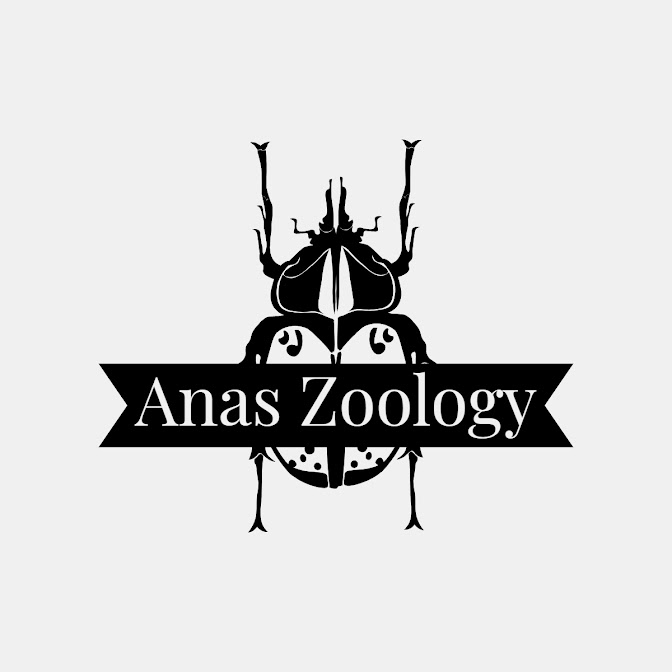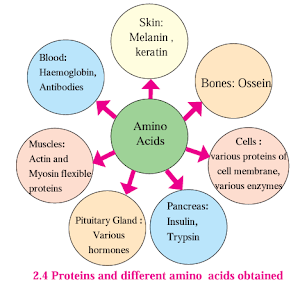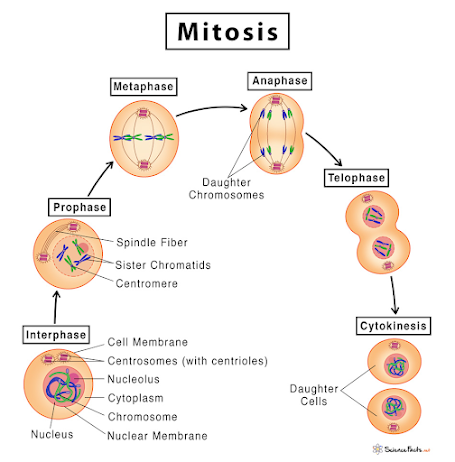Chapter 2. Life Processes in Living Organisms - Part I
2. Life Processes in Living Organisms - Part I
✱ Energy from different food components:
- Various organ-systems perform their functions in human body.
- Digestive system, respiratory system, circulatory system, excretory system, nervous system.
- All these system require energy.
- Energy is obtained from food.
- Food contains nutrients like carbohydrates, proteins, fats.
- For obtaining energy only nutrients are not sufficient, but oxygen is also necessary. All these foodstuff and oxygen are transported up to the cell via a circulatory system.
1. Carbohydrates:
- Sources of carbohydrates: Milk, fruits, jaggary, cane sugar, vegetables, potatoes, sweet meats and cereals like wheat, maize, ragi, jowar, millet, rice etc.
- 1 gm of carbohydrate = 4 Kcal of energy (Kcal = Kilocalorie)
2. Proteins:
- Sources of proteins: Pulses, egg, fish, chicken, mutton.
- Animal proteins are called 'first class' protein.
- 1 gm protein = 4 Kcal of energy.
- Proteins are formed by amino acids. Hence on digestion, proteins breakdown to give amino acids.
- Amino acids are absorbed in the body and transported to each organ and cell via blood.
- From these amino acids, organs and cells produce various proteins necessary for themselves and whole body.
- The different types of proteins formed from amino acids are given in the above figure.
- Excess of amino acids are broken down and the ammonia formed is eliminated out of the body.
- If necessary, excess of proteins are converted into glucose through the process of gluconeogenesis.
- An enzyme RUBISCO (Ribulose bisphosphate carboxylase oxygenase) present in plant chloroplast is most abundant protein found in nature.
3. Lipids (Fats):
- The substances formed by specific chemical bond between fatty acids and alcohol are called as lipids,
- Lipids after digestion break-down into fatty acid and alcohol.
- The molecules called as phospholipids which are essential for producing plasma membrane are formed from fatty acids.
- Beside, fatty acids are used for producing hormones like progesterone, estrogen, testosterone and aldosterone.
- The covering around the axons of nerve cells called myelin sheath are made up of fatty acids.
- 1 gm of fat = 9 Kcal of energy.
- Excess of lipids are stored in adipose connective tissue in the body.
4. Vitamins:
- Group of heterogenous compounds, each is essential for proper operation of various processes in the body.
- Main six types of vitamins: A, B, C, D, E and K
- Fat soluble vitamins: Vitamin A, D, E and K.
- Water soluble vitamins: Vitamin B and C
5. Water:
- 65-70% water is present in our body.
- Blood plasma also contains 90% water.
- Each cell contains 70% water weight by weight.
- Hence water is an essential nutrient.
- Functioning of cells and thereby whole body disturbs even if there is a little loss of water from the body.
✱ Energy Production:
- Respiration occurs at two levels 1) Body level respiration
- Body level respiration: Exchange of oxygen and carbon dioxide
- Cellular level respiration: Foodstuff are oxidized either with or without help of oxygen.
- Glucose is oxidized in three steps: 1) Glycolysis
3) ETC reaction (Electron Transfer Chain)
- Energy is obtained in the form of ATP (Adenosine Tri Phosphate)
1. Glycolysis:
- Discovered by 3 scientists - Gustav Embden, Otto Meyerhof and Jacob Parnas. Hence glycolysis is also known as EMP Pathway.
- Glycolysis occurs in cytoplasm.
- A molecule of glucose is oxidized step by step in this process and 2 molecules of pyruvic acid, 2 molecules of ATP, 2 molecules of NADH2 and 2 molecules of H2O (water) is formed.
- 2 molecules of Pyruvic acid formed in this process is converted into 2 molecules of Acetyl-Coenzyme-A (Acetyl-CoA). Two
molecules of NADH2 and 2 molecules of CO2 is released in
this process.
2. Tricarboxylic Acid Cycle (TCA cycle) / Krebs cycle:
- Krebs cycle was discovered by Sir Hans Krebs.
- Acetyl-CoA enters mitochondria.
- Acetyl part of Acetyl-CoA is completely oxidized.
- 1 molecule of ATP, 3 molecules of NADH2, 1 molecule of FADH2, H2O and CO2 are obtained from 1 Acetyl-CoA.
- But we obtained 2 molecules of Acetyl-CoA. So, from 2 molecules of Acetyl-CoA we will get 2 molecules of ATP, 6 molecules of NADH2, 2 molecule of FADH2, 2 molecules of H2O and 2 molecules of CO2
3. ETC Reaction (Electron Transfer Chain):
- Oxygen is required in this process.
- 1 NADH2 = 3 ATP
- 1 FADH2 = 2 ATP
- Water molecules are also formed.
- ETC occurs in mitochondria only.
✱ How much energy is obtained from one glucose molecule?
- Glycolysis
We also
obtain 2 molecules of NADH2. 1
NADH2 gives us 3 ATP in the ETC. So 2 NADH2 will give us
6 ATP.
Total = 2 ATP + 6 ATP = 8 ATP
2 molecules of Pyruvic acid gets converted into 2 molecules of Acetyl-CoA, while doing so we get 2 molecules
of NADH2.
We know that 1 NADH2 = 3 ATP, so 2 NADH2 =
6 ATP
- Krebs Cycle
We get 2 ATP, 6 NADH2
which is equal to 18 ATP. We also get 2 molecules of FADH2. 1
FADH2 = 2 ATP therefor 2 FADH2 = 4 ATP.
We get a total of 2 + 18 + 4 = 24 ATP from Krebs cycle
Total no of ATP obtained = 8+6+24 = 38 ATP.
Hence we get a total of 38 ATP from one molecule of glucose.
✱ ATP (Adenosine Tri Phosphate)
- Adenine + Ribose sugar = Adenosine
- Adenosine + 3 Phosphate group = ATP
- ATP is an energy rich molecule
- Energy is stored in the bonds by which phosphate groups are attached to each other.
- Energy is derived by breaking the phosphate bond of ATP.
✱ Respiration:
- Respiration is of 2 types
- Aerobic Respiration: In presence of oxygen
- Anaerobic Respiration: In absence of oxygen
- Anaerobic respiration: Glucose is completely oxidized and less amount of energy is obtained. It takes place in 2 steps:
- Glycolysis:
Glucose 一一一一一〉 Pyruvic acid
2. Fermentation:
Pyruvic acid 一一一一一〉Alcohol + CO2 +
Energy
Pyruvic acid 一一一一一〉Lactic acid + CO2 +
Energy
- Examples:
- Many bacteria perform anaerobic respiration.
- Some plants, animals and aerobic microorganisms also perform anaerobic respiration if there is depletion in oxygen level in the surrounding.
- Seeds perform anaerobic respiration if the soil is submerged under water.
- Our muscle cells also perform anaerobic respiration while performing the exercise. Due to this, less amount of energy is produced in our body and lactic acid accumulates due to which we feel tired.
✱ Cell Division:
- Cell division is of 2 types
- Mitosis: Takes place in somatic cells.
- Meiosis: Takes place in germ cells.
- In one human cell there are 46 chromosomes.
- So there are 23 pairs.
- Diploid condition = 2n (n = Number of chromosomes in haploid condition)
- Before the cell divides, the chromosomes always duplicate.
- Sister chromatids separate to form daughter cells.
✱ Mitosis:
- Mitosis occurs in 2 phases: Karyokinesis and Cytokinesis
- Karyokinesis: Nuclear division (Division of nucleus)
- Cytokinesis: Cytoplasmic division (Division of cytoplasm)
Karyokinesis is divided into 4 stages named: Prophase, Metaphase, Anaphase and Telophase
1) Prophase:
- Condensation of chromosome takes place.
- Chromosomes become short and thick.
- Appear with their sister chromatids.
- Centrioles duplicate and each centriole move towards opposite poles of the cell.
- Nuclear membrane and nucleolus start to disappear.
2) Metaphase:
- Nuclear membrane and nucleolus completely disappear.
- Chromosomes complete their condensation.
- All chromosomes are arranged parallel to equatorial plane of the cell.
- Spindle fibers are formed between centromeres of each chromosome and both centrioles.
3) Anaphase:
- Centromeres split and thereby sister chromatids of each chromosome separate.
- They are pulled apart in opposite direction with the help of spindle fibers.
- Separated sister chromatids are called as daughter chromosomes.
4) Telophase:
- Chromosomes now start to decondense and again become thread like thin and invisible.
- Nuclear membrane is formed around each set of chromosome reached at poles.
- Thus, two daughter nuclei are formed in the cell.
- Nucleolus also appears in each daughter nucleus.
- Spindle fibers completely disappear.
Cytokinesis:
- The cytoplasm divides and two daughter cells are formed.
- In this process, a notch is formed at the equatorial plane of the cell.
- It deepens gradually and thereby two new cells are formed.
In plant cells:
- A cell plate is formed at the midline of the cell.
- Cell plate grows gradually and cytokinesis is completed.






Comments
Post a Comment